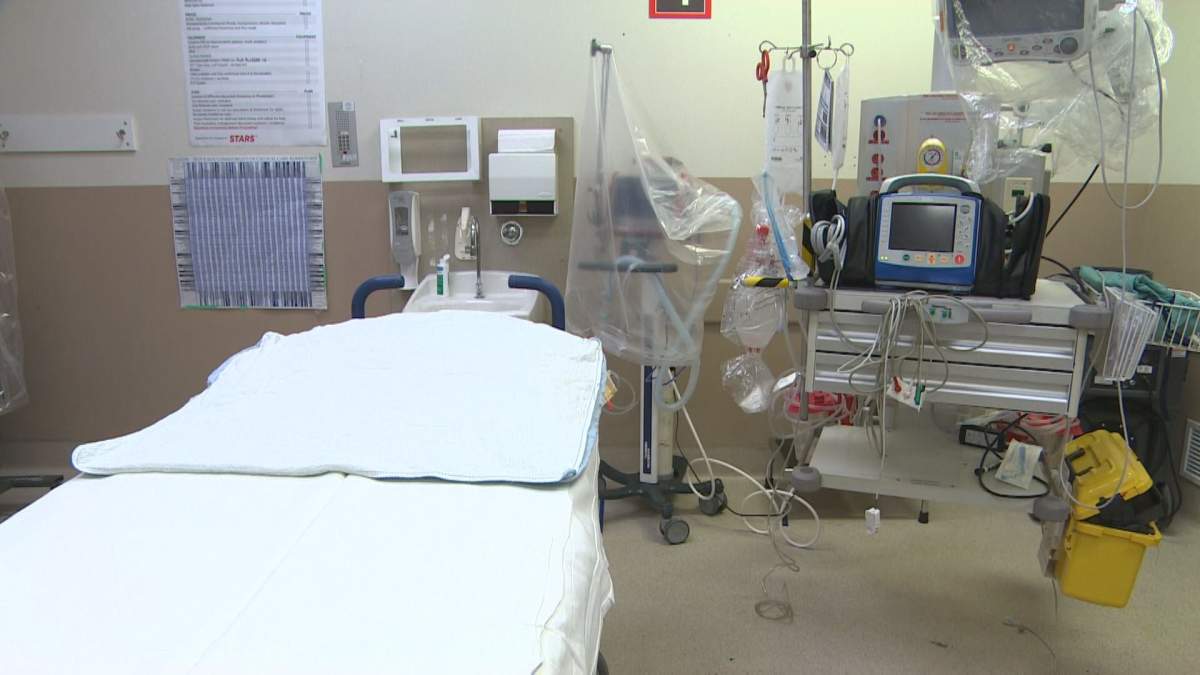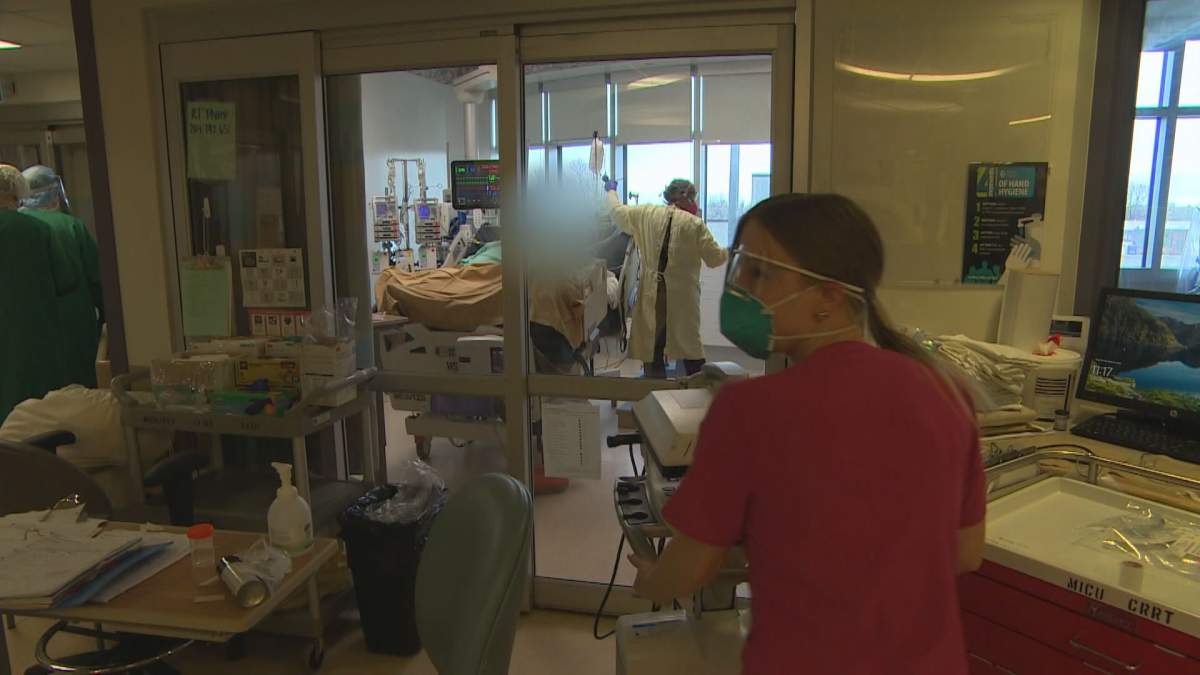The COVID-19 pandemic has intensified the workload at Winnipeg’s Health Sciences Centre (HSC), where staff report a difficult and anxiety-filled transition into the unknown.

And yet, 10 months after being thrust into the largest health crisis in a generation, those health-care workers have found an uneasy rhythm amongst the difficult, stressful situations most of the rest of the province doesn’t see.
“The work that’s been involved, by everybody involved, has been staggering,” says John Embil, medical director of infection prevention and control at HSC, who adds it’s an ever-evolving situation.
“This could become a patient treatment area if you needed,” he says, gesturing around the room.
“Tanks of oxygen, you take out the desks, put in some beds, you bring in some nurses, you’ve got a patient treatment area. Somewhat unconventional, but it can be done.”
And indeed it has been done many times, as the city’s test-positivity rate remains around 13 – 14 per cent, and well over 100 new cases are added in Winnipeg alone each day.
“We can find empty space anywhere, but it’s how do you operationalize it?” says Jennifer Cumpsty, acting chief nursing officer at HSC.
“Staff are working overtime, they are stretched beyond right now. And as the need comes for beds, the patients aren’t going away, and we just keep getting thinner and thinner as our footprint expands.”
One of those areas, GD2, was formerly an orthopedic unit, but now it’s a red zone COVID unit.
Manager of patient care for the unit, Anna Marie Papiz, says all 30 beds are full most days, and the transition has been hard on her team.
“The numbers of patients we’re sending up to MICU (medical intensive care unit), the number of deaths that we are encountering is far greater than we’ve experienced as surgical nurses,” Papiz says, adding the challenges are compounded by a staffing shortage.
“Certainly when we became a red zone area, everybody has their fears, that’s only natural. So working through those fears, a lot of staff working overtime, missing breaks, just to take care of everybody has been for some people taking its toll for sure.
“Here we are several weeks later as a COVID positive unit and what we’re hearing much more from staff is they’re feeling safer on a red zone unit because they know these patients are COVID positive, and they can wear all that extra PPE. The piece that frightens them more is going outside of these areas and outside of even the walls of this facility where we don’t know who might be carrying that virus.”
As the mindset of the workers changes, and what were once waiting areas change into treatment units, so too have the patients coming through the doors changed.
In the spring, many of those experiencing severe outcomes were generally older people, according to Dr. Bojan Paunovic, an intensive care physician and provincial lead for critical care.

Get daily National news
Now, he sees a consistent stream of people in their 40s and 50s.
Dr. Paunovic says he’s witnessed other viral infections before, such as H1N1 and the usual flu that comes around every year, but COVID-19 is much more severe, manifesting as extra inflammation and significant scarring of the lungs.
“So that translates into people needing to be on the ventilator longer, and taking longer to recover even when they get off the ventilator in terms of being able to have their normal activity levels and be liberated from oxygen even,” Dr. Paunovic says.
Many people are eventually weaned off the ventilators, but given the significant number of people being admitted, Dr. Paunovic says too many never see the day when they can breathe on their own.
“We’re used to the concept of, at a certain point, whatever we’re doing isn’t working, or the patient continues to deteriorate, and then we have to transition to palliation. The process there though would be engaging the families, supporting the families, usually in person.”
However, given the nature of the pandemic, and the need for visitor restrictions, family contact is oftentimes limited to end-of-life calls through an iPad or over the phone, which Dr. Paunovic says happens “numerous” times every week.
“This is pretty stressful for families, obviously. It’s also very stressful for the staff who are feeling an obligation to provide that support in person. That said, the staff have risen to that challenge.”
Aaron Turner was working in orthopedics only a few weeks ago, and now works in a red zone COVID unit.
He and his colleagues are helping patients who are much sicker than they’re used to, he says, and describes the environment as extremely stressful for everyone involved.
“I myself have been involved in a few of those conversations with people who were on comfort care,” Turner says.
“And I was responsible for setting them up with an iPad so they could say their goodbyes. Seeing that is very emotional, and very difficult. So that’s an impact that we’re kind of taking on as well; seeing that and being a part of that.”
Before patients are admitted to the red zone, though, many find themselves waiting for rooms and COVID-19 test results in the emergency department.
This from Dr. Shelly Zubert, assistant director of the emergency department, who says anywhere between 16 and 27 people could be boarded in the emergency department on a given day.
“There’s been some talk that emergency departments don’t look that busy, but I assure you it feels like we’re very busy,” says Dr. Zubert, who adds with the high level of community transmission right now, they must assume most people coming in have been exposed to the virus.
“We approach them in full PPE for every approach to the patient, so that creates a huge amount of extra workload, (and a) risk to the health-care workers, because every time you don and doff … your PPE, is a very high-risk moment,”
Dr. Zubert says more patients are passing through her unit because of the pandemic, and generally they’re staying longer.
“The labs are working very hard for us, but those lab test results take many hours, and often result in overnight stays in the emergency department because those labs aren’t working around the clock,” Dr. Zubert says.
Manitoba Nurses’ Union president Darlene Jackson says the stories of health-care workers’ intense shifts, little time for breaks, and stress brought on by being surrounded by critically ill patients and death are increasing exponentially.
“You absolutely have to feel it in your heart when you have to go through that several hundred times a week,” Jackson says.
She feels that although government and health care officials planned for the eventual second wave during the summer, “so much more” could have been done, and that front-line health care workers should have been more involved in that planning.
“We’ve really got to get proactive, we’ve really got to look at ways that we can bring others into the ICU. We could really optimize what we’ve got here,” Jackson says.
Although she adds: “nurses are stepping up to the challenge like we do all the time.”














Comments